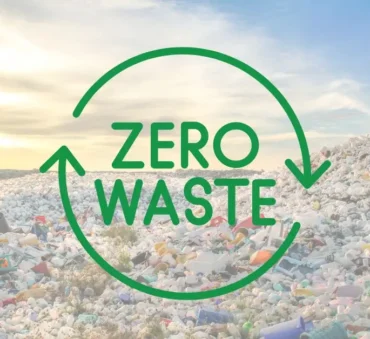Imagine this: Rather than throwing away a product or material, it’s kept in circulation to reduce waste and maximize its value.
What we just described is circular waste management, an approach that keeps resources in use as long as possible. This challenges the traditional linear model, replacing the “take-make-dispose” cycle with sustainability.
Since this approach has environmental, economic, and social benefits, companies have much to gain from implementing a circular management system. And unsurprisingly, the more that join this movement, the better.
Keep reading to explore the benefits of a waste management system, tips for building a circular waste model, and more.
Key Takeaways
- Circular principles should be at the foundation of every business process, which can be achieved by eliminating waste and pollution, circulating products and materials, and regenerating nature.
- Keeping materials in circulation not only helps companies cut raw material costs and lower expenses but also creates new revenue opportunities through upcycling.
- Circular models require strong collection and processing infrastructure, such as material recovery centers, recycling facilities, and reliable transportation.
- Tracking circular waste performance is a critical part of every company’s strategy, which can be done by monitoring waste diversion, emissions reductions, and resource recirculation.
What is Circular Waste Management?
Circular waste management is a closed-loop system that aims to minimize waste by reusing, recycling, and repurposing materials so they remain in circulation.
According to the Ellen MacArthur Foundation, the circular economy is based on three principles, driven by design:
- Eliminate waste and pollution
- Circulate products and materials (at their highest value)
- Regenerate nature

Source: European Parliament Research Service
Differences Between Circular Waste Management vs. Traditional Waste Management
Circular management systems prioritize reduction, reuse, and recycling over disposal.
Traditional waste management follows a “take-make-dispose” model characterized by resource depletion. This approach uses two main methods for disposal: landfilling and incineration.
Let’s take a look at how these approaches differ in handling beer waste. In traditional waste management, spent grains often end up in landfills, contributing to environmental pollution and the loss of a valuable resource.
Companies that implement a circular brewery, on the other hand, can upcycle spent grains into food products and animal feed, use them as feedstock for anaerobic digestion, or compost organic waste.
Benefits of Circular Waste Management
Circular waste management delivers environmental, social, and economic value, as discussed below.
1. Environmental
Perhaps the greatest advantage of circular waste management is its role in mitigating the negative environmental impact of waste. Let us explain.
When products are not kept in circulation, it leads to resource depletion, biodiversity loss, and the accumulation of waste that drives pollution and climate change. Traditional waste management also contributes to greenhouse gas emissions, both during manufacturing and in landfills.
Circular waste addresses these concerns by maximizing the value of products. By keeping resources in circulation, circular waste management helps conserve ecosystems, lower emissions, and ease the strain on our planet’s natural resources.
For instance, fighting food waste with circular economy increases resource efficiency, improves food security, and reduces carbon emissions from food waste.
2. Social
Circular economy and waste management contribute to social well-being by generating positive impacts that strengthen communities and improve quality of life. There are multiple ways it accomplishes this.
To start, circular management systems support local economies by generating new jobs, with estimates suggesting that seven to eight million positions could be created in the circular economy.
Even more, circular economies make goods more affordable by designing products to be more durable and reusable, supporting programs like food rescue, and fostering a culture of smart consumption.
Overall, it helps build stronger, more resilient communities by encouraging collaboration and shared responsibility.
3. Economic
Keeping materials in circulation helps companies cut raw material costs and lower overall expenses.
This approach also opens new business opportunities, such as creating revenue streams through upcycling. Composting for businesses is a great example of this. Rather than sending organic waste to landfills, it can be converted into nutrient-rich compost that supports the agricultural sector.
And as mentioned, one of the benefits of a waste management system is job creation, contributing to economic growth and stability.
With the circular economy potentially generating $4.5 trillion of additional economic output by 2030, companies that embrace it stand to gain both financially and sustainably.
Roadmap for Companies: Building a Circular Waste Model
Adopting a circular waste model requires a detailed strategy that outlines your vision, infrastructure, compliance requirements, and other key factors.
1. Strategy and Vision
Every company relies on different materials, production methods, and long-term objectives. For that reason, each company must ask itself: What does a circular management system mean for our operations?
For some, it may mean sourcing sustainable or recyclable materials, while for others it may mean implementing a composting program. What’s important is that each company’s strategy aligns with their sustainability goals and has clear metrics to measure progress.
2. Organization System Redesign
Circular principles should be at the foundation of every business process. As outlined by the Ellen MacArthur Foundation, this can be achieved by eliminating waste and pollution, circulating products and materials, and regenerating nature.
Let’s see how this model may look for a restaurant:
- Eliminate waste and pollution: Restaurants can perform food waste audits to identify waste sources and quantities, thereby helping them implement more effective waste prevention strategies.
- Circulate products and materials: They can donate excess meals through food rescue programs or use surplus ingredients to create new menu items.
- Regenerate nature: They can compost organic scraps to enrich soil, support local farms, and reduce reliance on chemical fertilizers.
3. Infrastructure and Logistics
Circular models require strong collection and processing infrastructure, such as material recovery centers, recycling facilities, and reliable transportation. Investing in the right infrastructure not only streamlines operations but also maximizes the environmental and economic benefits of circular waste management.
Companies have two options: handle this process themselves or partner with a food waste recycling company like Shapiro. Companies should consider factors like resources and long-term sustainability goals before deciding which approach is the most practical.
4. Policy Alignment and Incentives
Companies must align internal processes and strategies with evolving policies, many of which are introduced at the state level.
For instance, the majority of U.S. states have policies in place that would support donation of excess food for human use, and a few mandate wasted food management through landfill bans or diversion targets.
Another example is the NYS Electronic Equipment Recycling and Reuse Act and the supporting Subpart 368-3 regulations, which require manufacturers to provide free and convenient recycling of electronic waste to most consumers in the state.
All things considered, companies must understand and adapt to the diverse state-level regulations that apply to their operations to ensure compliance.
5. Technology and Innovation
Companies that adopt advanced technologies are better positioned to create scalable, data-driven models for resource circulation.
Depending on your strategy, there are a number of ways technologies can be leveraged to improve efficiency. For instance, AI-powered tools streamline waste sorting and material tracking, digital platforms coordinate collection schedules more efficiently, and data analytics identify trends that support smarter resource allocation.
By adopting new technologies, companies can reduce waste, lower operational costs, and enhance sustainability.
6. Measuring and Evaluations
Tracking circular waste performance is a critical part of every company’s strategy, which can be done by monitoring waste diversion, emissions reductions, and resource recirculation.
A study on circular economy performance assessments states that Life Cycle Assessments are still the most common way to measure the environmental impact of circular systems throughout their lifecycle. Companies can also adopt digital monitoring tools and standardized reporting frameworks to gain a clearer, more actionable view of their sustainability progress—and adjust their strategy if needed to improve performance.
Challenges in Implementing Circular Waste Management
Like any new initiative, it comes with its challenges. Let’s take a look at potential obstacles and how to manage them.
1. Economic Barriers
Implementing a circular waste model requires company-wide changes. Not only does this mean employee training, but also investment in new systems, processes, and infrastructure—all of which can be costly.
Companies can reduce initial expenses by partnering with a waste management company that already has infrastructure in place. Over time, these efforts can also lower operating expenses by minimizing waste disposal fees, improving efficiency, and maximizing resource use.
2. Policy and Coordination Gaps
As mentioned above, many states have their own laws regarding circular waste management, making it hard for companies to navigate compliance requirements. And since noncompliance can lead to fines and damage a company’s reputation, this is a big concern for companies of all sizes.
To address this, you can either hire an internal compliance expert or partner with waste management specialists who ensure regulations are met across different regions.
3. Data Measurement & Monitoring gaps
Data measurement and monitoring gaps make it difficult for companies to track waste generation, material flows, and overall performance. Without reliable data and consistent metrics, it becomes nearly impossible to identify inefficiencies, demonstrate progress, or refine circular waste strategies effectively.
As we discussed, technology plays a big role in enhancing processes. That said, companies can overcome this challenge by implementing digital monitoring tools and standardized reporting systems that provide real-time insights.
4. Lack of Infrastructure
And of course, we can’t discuss obstacles without mentioning infrastructure. Many companies don’t have the resources to invest in the storage, transportation, and treatment of materials, or the personnel needed to manage them. However, this doesn’t mean they can’t implement a circular management system.
Instead, they can hire a waste management company that specializes in circular solutions, providing the expertise, infrastructure, and services needed to handle materials responsibly and cost-effectively.
Conclusion
Circular waste management maximizes the value of products, lowers greenhouse gas emissions, conserves ecosystems, and supports a more sustainable future.
With our services, you can implement an environmentally friendly waste management approach that extends the life of materials. Whether you’re interested in composting, turning waste to energy, or exploring other solutions, we’ll create a tailored strategy that fits your unique business needs.
Contact us today to discuss our services.
FAQs about Circular Waste Management
Yes, there are many statewide laws that support circular practices, including food donation policies, landfill bans, and requirements for convenient electronic waste recycling.
Small businesses can design products with durability and reusability in mind, implement lean manufacturing principles, integrate recycled materials into production processes, and partner with a waste management company to streamline efforts.
Industries that benefit most from circular waste management include food, agriculture, manufacturing, construction, electronics, and fashion, though all industries can benefit from adopting circular practices.
Coca-Cola is a great example of the circular economy, using reusable PET bottles that are refilled up to 25 times across multiple soda brands in Latin America, reducing plastic use by 90%. Check out these additional case studies to see more examples of circular economy in action.
Baily Ramsey, an accomplished marketing specialist, brings a unique blend of anthropological insight and marketing finesse to the digital landscape. Specializing in educational content creation, she creates content for various industries, with a particular interest in environmental initiatives.



